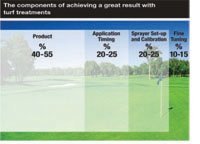
By Ryan Beauchamp, Turf Specialist
Syngenta Crop Protection Canada
There is an auto insurance commercial that makes reference to our
complacent habits with essential life choices—“people spend more time
on average selecting a video to rent, than time to renew their auto
insurance.” Coincidentally, spray nozzle selection in the turf industry
is a comparable scenario.
A set of spray nozzles will cost on average under $200. Unfortunately, many superintendents feel this is of lowest priority within a spray operation and spend little to no time investigating their options. When you consider that the average golf course will spend anywhere between $15,000 and $100,000 annually on chemical products, with up to 45 per cent success not actually based on the product used—a whopping $45,000 can actually be wasted during a single season! If you ask the question—when does a product work best?—the answer…when it’s in the bottle. 
Brand products that are available within the Canadian turf industry are extensively researched and they work. The majority of problems occur between the product leaving the jug and hitting the target. Understanding the process of getting the spray from the jug to the target will assist a course manager to squeeze towards 100 per cent success. The reality is that only 55 per cent of a spray product’s success is actually based on the product being applied. The balance is affected by other factors that include nozzle selection, sprayer calibration and application timing, to name a few.
As a superintendent, I was equally guilty when selecting an appropriate spray nozzle, and consequently, similar disappointing results. As with many turf managers today, the blame cannot entirely rest on my shoulders since nozzle selection training and the basic “Art of Application” has been missing from academia within our industry. Using swirl chamber “rain-drop” nozzles for all spray applications was the weapon of choice 20 years ago, and there was little thought toward water volume or coverage. In my travels today, it is still common to see golf courses utilizing these same incorrect nozzles, and, to no surprise, similar poor results.
Understanding your options
You need to start by understanding your target. A foliar application requires excellent leaf coverage for any true foliar fertilizer and contact fungicide application. The following chart shows the XR, Turbo Teejet and Ai nozzles as choice products.
The two nozzles that should never have foliar fungicides applied through are the TurfJet or raindrop nozzle. Unfortunately, these nozzles are commonly utilized at many golf facilities today and should be reserved for soil targeting product applications.
The AI and XR nozzles provide much better coverage and will dramatically improve foliar product efficacy, but only if applied at correct water volumes of 4-8L/100m2. For example, if a contact fungicide was to be applied with too high water volume, you will mistakenly target the crown and roots of the plant and not the leaf. This may cause the contact portion of this fungicide to not provide optimum protection. Your first reaction may be to blame a product applied when in actual fact it is the equipment. A 4-8L/100m2 Ai or XR @ 110º would work best in this application.
When it comes to drift control, the rain-drop, Turf Jet & Ai nozzles take the pole position. Only the Ai nozzle ranks high for both scenarios and therefore becomes the most versatile if you are limited to working with only one nozzle on your sprayer. Fortunately, sprayers can easily be set up with a multi-body selector to accommodate three or more nozzle types.
Fungicide efficacy complaints are usually related to one of two things: 1. Timing 2. Coverage.
Timing, e.g. too late in the disease development cycle means that disease is already well established, putting a fungicide under enormous pressure.
Coverage, water-sensitive paper on the left has been over sprayed with a conventional flat fan nozzle. This gives excellent coverage but, because of the range of droplet sizes created, produces a considerable amount of fine droplets which drift. The water-sensitive paper on the right has been oversprayed with a bubble jet nozzle which gives poorer coverage but is more directional. The utopian compromise would be to maintain the level of coverage from the flat fan, but to incorporate the reduced drift offered by the bubble jet nozzle.
Drift issues generally come from fine droplets created within the droplet spectrum from flat fan or finer nozzles. Calibration, sprayer maintenance and checks are all crucial to ensure accurate application. Unfortunately, it isn’t as simple as saying use a flat fan nozzle. Flat fan nozzles come in a wide variety of droplet sizes. If the droplet is too large, then disease control may be adversely affected. If the droplet is too small, it may move off target with the wind.
With regards to a standard foliar fungicide application, your percentage of success will improve with the following guidelines:
Use 80º XR only if using a covered boom system.
What they neglect to say:
• TurfJet: Only use for soil applied products; you need to install a 90-degree elbow on most booms
• XR nozzles: 80º spray angles need to be raised to height of .75m. These should be avoided as drift possibilities will increase.
• Air induction (Ai) nozzles: should not be used under covered booms; if you use a wetting agent, sticking agent or de-foamer, the nozzle may not work; dust may plug the air inlet
I can recall another commercial that states, “You can pay me now, or pay me later.” Spending a little time up front researching “the fine art of spray application” will not only improve your results, but could boost your club’s bottom line in these tough economic times.
Print this page